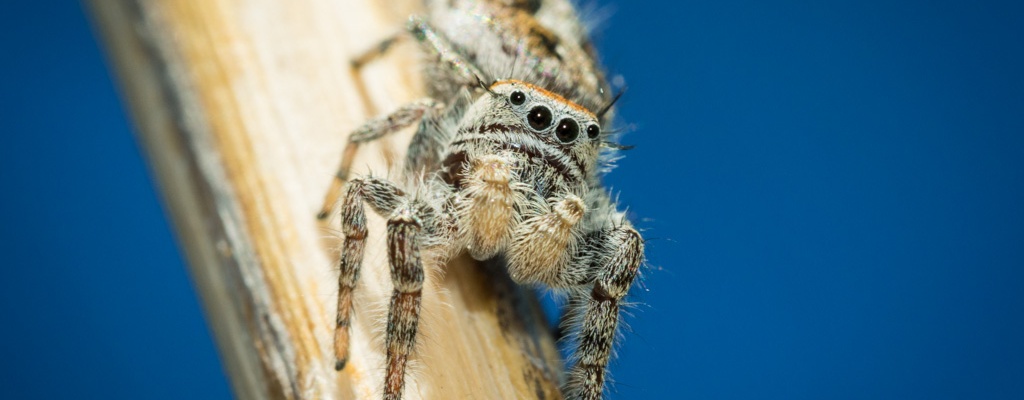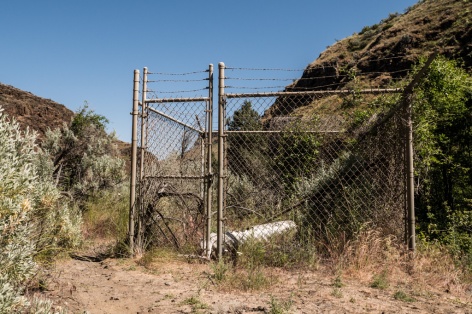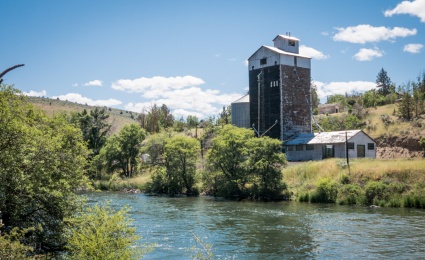 Just a short 3 to 4 hour drive from Corvallis and a small trip around Mt. Hood is Maupin, a small town in North Central Oregon along the Deschutes River. Maupin is heavily decorated with fly fishing stores and shops to book guided river rafting tours. The elementary school has a painting of a fish on it’s front door, and there might be more campsites and day-use fishing areas than permanent residences. It’s evidently a popular tourist destination, indicated by the high number of people in the Maupin Market that were completely unfamiliar with how the dry-erase sandwich order form worked. Despite it’s obvious affection for the river, The Maupin Market has a surprising lack of fish for sale, but makes up for it in abundance of other deli snacks, including some very tasty pork tacos.
Just a short 3 to 4 hour drive from Corvallis and a small trip around Mt. Hood is Maupin, a small town in North Central Oregon along the Deschutes River. Maupin is heavily decorated with fly fishing stores and shops to book guided river rafting tours. The elementary school has a painting of a fish on it’s front door, and there might be more campsites and day-use fishing areas than permanent residences. It’s evidently a popular tourist destination, indicated by the high number of people in the Maupin Market that were completely unfamiliar with how the dry-erase sandwich order form worked. Despite it’s obvious affection for the river, The Maupin Market has a surprising lack of fish for sale, but makes up for it in abundance of other deli snacks, including some very tasty pork tacos.
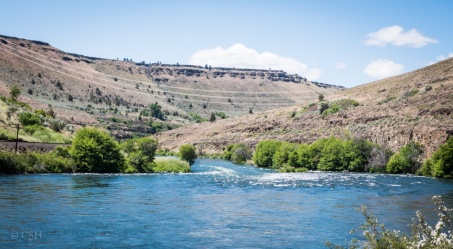 Last September, my colleague Phill and I headed out here looking for Brochymena sp., the rough stink bug. This is a genus that had given us grief not only in finding but also rearing. When we had managed to track any down, we found only individuals, and it was generally on a cement wall or on a sidewalk, instead of a host plant suggesting where where we might want to look for more. Upon getting them into the lab, they generally perished within one or two days, never mating or laying eggs and only rarely feeding. Another ODA trapper had found a few earlier in the season, and so we had a good lead on a population that existed in a state park near Maupin. We took an overnight trip east to have a look. Rising early in the morning after a freezing night camping along the river, we found a large population at a site along the White River just north of town. Unfortunately, it being so late in the summer, these stink bugs were ready to overwinter for the season, which meant no eggs. In the lab, they didn’t survive the winter and our lab colony died out before we were able to do any tests against the parasitoid.
Last September, my colleague Phill and I headed out here looking for Brochymena sp., the rough stink bug. This is a genus that had given us grief not only in finding but also rearing. When we had managed to track any down, we found only individuals, and it was generally on a cement wall or on a sidewalk, instead of a host plant suggesting where where we might want to look for more. Upon getting them into the lab, they generally perished within one or two days, never mating or laying eggs and only rarely feeding. Another ODA trapper had found a few earlier in the season, and so we had a good lead on a population that existed in a state park near Maupin. We took an overnight trip east to have a look. Rising early in the morning after a freezing night camping along the river, we found a large population at a site along the White River just north of town. Unfortunately, it being so late in the summer, these stink bugs were ready to overwinter for the season, which meant no eggs. In the lab, they didn’t survive the winter and our lab colony died out before we were able to do any tests against the parasitoid.
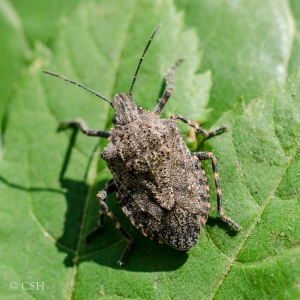 I wanted to get back there earlier this year to get some Brochymena that were just coming out of overwintering. The likelihood that these would be ready to mate and lay eggs would be higher that the ones we found last year. In general, stink bugs in Oregon have one or two generations a year. An adult population will spend the winter in diapause, waiting out the cold in some kind of protected area (under tree bark or in an attic, for example). When the weather warms up and the daylight length increases, they emerge, mate, and die. Their offspring feed and mature all summer, and then in Fall find shelter and become the overwintering population. This is why if you have brown marmorated stink bugs in your area, you see them on your house in the early spring, and then again in the late summer, and occasionally in your home during the winter. In the summer, they are around the neighborhood feeding.
I wanted to get back there earlier this year to get some Brochymena that were just coming out of overwintering. The likelihood that these would be ready to mate and lay eggs would be higher that the ones we found last year. In general, stink bugs in Oregon have one or two generations a year. An adult population will spend the winter in diapause, waiting out the cold in some kind of protected area (under tree bark or in an attic, for example). When the weather warms up and the daylight length increases, they emerge, mate, and die. Their offspring feed and mature all summer, and then in Fall find shelter and become the overwintering population. This is why if you have brown marmorated stink bugs in your area, you see them on your house in the early spring, and then again in the late summer, and occasionally in your home during the winter. In the summer, they are around the neighborhood feeding.
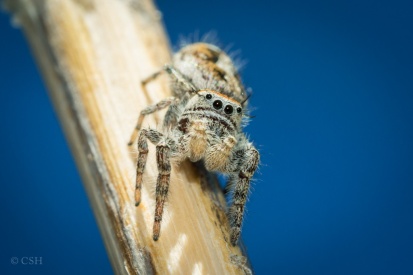 I arrived in sunny Maupin around 10:30 a.m., where the shores of the Deschutes were spotted with anglers. At the city park, a group of folks in their blazing orange life jackets were sliding an inflatable raft into the fast water. I drove through town and over a narrow bridge onto Bakeoven Road that runs opposite an old but functioning iron railway. I was looking for a spot that had a lot of vegetation along the shore, but I also wanted to avoid any place that was already occupied by fisherman for fear of disturbing their recreation and having to answer a lot of questions. Not too far up the river was a small picnic area and after parking, I threw together my beat sheet, strapped on my collecting jar (I wear one on a belt; I’ve been working to streamline my collecting) and got to work.
I arrived in sunny Maupin around 10:30 a.m., where the shores of the Deschutes were spotted with anglers. At the city park, a group of folks in their blazing orange life jackets were sliding an inflatable raft into the fast water. I drove through town and over a narrow bridge onto Bakeoven Road that runs opposite an old but functioning iron railway. I was looking for a spot that had a lot of vegetation along the shore, but I also wanted to avoid any place that was already occupied by fisherman for fear of disturbing their recreation and having to answer a lot of questions. Not too far up the river was a small picnic area and after parking, I threw together my beat sheet, strapped on my collecting jar (I wear one on a belt; I’ve been working to streamline my collecting) and got to work.
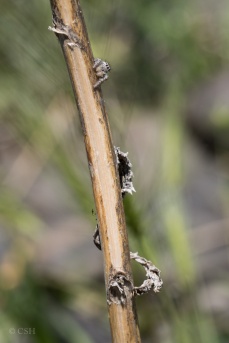 Grass had grown as high as my shoulders all the way up from the roadway to the shore, but I managed a path to the alder trees along the sandy banks. On some of the larger grass stems, jumping spiders were running up and down looking for prey. Some were obvious because they were moving, but once I stopped and started looking more closely, I could see there were probably hundreds in the grass surrounding me, their grey, brown and orange patterns perfectly camouflaging their bodies. I started sampling the trees near the water and on the first hit, Brochymena quadripustulata tumbled out onto my sheet. Brochymena has a characteristic sweet defense odor that resembles maraschino cherry (according to OSU Enologist Elizabeth Tomasino). Often, I can smell the stink bugs on my sheet before I see them, especially if there is a lot of debris coming out of the bushes and trees. A few more hits, many more rough stink bugs. There were also many Chinavia hilaris blackberries, another species that I needed (but is fairly common in the Willamette Valley). At this point, I was already set to call the trip a total success. Then I found a tick in my sweep net which gave me a terrible creepy crawly feeling that lingered for the rest of the afternoon.
Grass had grown as high as my shoulders all the way up from the roadway to the shore, but I managed a path to the alder trees along the sandy banks. On some of the larger grass stems, jumping spiders were running up and down looking for prey. Some were obvious because they were moving, but once I stopped and started looking more closely, I could see there were probably hundreds in the grass surrounding me, their grey, brown and orange patterns perfectly camouflaging their bodies. I started sampling the trees near the water and on the first hit, Brochymena quadripustulata tumbled out onto my sheet. Brochymena has a characteristic sweet defense odor that resembles maraschino cherry (according to OSU Enologist Elizabeth Tomasino). Often, I can smell the stink bugs on my sheet before I see them, especially if there is a lot of debris coming out of the bushes and trees. A few more hits, many more rough stink bugs. There were also many Chinavia hilaris blackberries, another species that I needed (but is fairly common in the Willamette Valley). At this point, I was already set to call the trip a total success. Then I found a tick in my sweep net which gave me a terrible creepy crawly feeling that lingered for the rest of the afternoon.
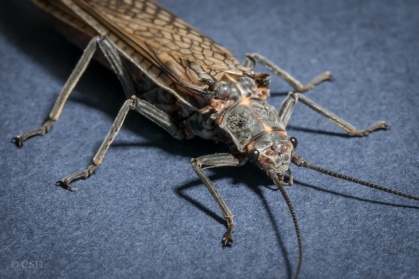 Giant stoneflies (Plecoptera: Pteronarcyidae) were all over the lower branches of the alder trees that overhung the river. These are likely familiar to any fly fishers or river rats. The name Plecoptera means “folded wings”, and their wings are folded flat against their backs. They also have two long “tails” or cerci that help to distinguish them from mayflies or other insects you’d find near the river. Immature stoneflies are aquatic and are found in fast moving, clean streams where they feed on algae and other aquatic vegetation. Adults are terrestrial, do not fly very well, and will remain close to the river. Although the immature stages can live for a few years before a final molt into adulthood, the adults only live for a few weeks and most don’t feed. You can often see their shed exoskeletons, or exuvia, attached to tree trunks and rocks that are right along river banks. Adult males will seek female mates by drumming their abdomen against rocks and other substrate. Stoneflies are an important food source for fish, and are flies are often made to mimic them by fishermen. This species is among the largest insects that I’ve seen in Oregon (around 4 cm long), although there are many smaller stonefly species in Oregon and around the world. They can look pretty intimidating but they are safe to handle.
Giant stoneflies (Plecoptera: Pteronarcyidae) were all over the lower branches of the alder trees that overhung the river. These are likely familiar to any fly fishers or river rats. The name Plecoptera means “folded wings”, and their wings are folded flat against their backs. They also have two long “tails” or cerci that help to distinguish them from mayflies or other insects you’d find near the river. Immature stoneflies are aquatic and are found in fast moving, clean streams where they feed on algae and other aquatic vegetation. Adults are terrestrial, do not fly very well, and will remain close to the river. Although the immature stages can live for a few years before a final molt into adulthood, the adults only live for a few weeks and most don’t feed. You can often see their shed exoskeletons, or exuvia, attached to tree trunks and rocks that are right along river banks. Adult males will seek female mates by drumming their abdomen against rocks and other substrate. Stoneflies are an important food source for fish, and are flies are often made to mimic them by fishermen. This species is among the largest insects that I’ve seen in Oregon (around 4 cm long), although there are many smaller stonefly species in Oregon and around the world. They can look pretty intimidating but they are safe to handle.
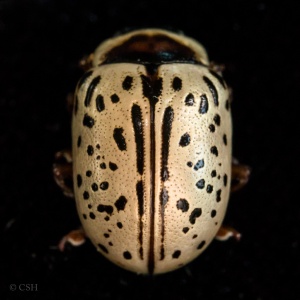 This beetle that I found alongside the stink bugs is a member of the family Chrysomelidae. It’s elytra (wing covers) are very ornate and almost look like they are carved from wood. From tip to tip it’s only about a centimeter long. On the beat sheet it remained inactive for a long time. The best match I could find was Calligrapha sp., from a specimen uploaded to Bugguide from around the same area. However, it’s best to be a little wary of IDs to species from photographs. Still, a very beautiful and unexpected find. This is the only beetle like this I’ve ever seen, though the the beetle family Chrysomelidae is a huge one.
This beetle that I found alongside the stink bugs is a member of the family Chrysomelidae. It’s elytra (wing covers) are very ornate and almost look like they are carved from wood. From tip to tip it’s only about a centimeter long. On the beat sheet it remained inactive for a long time. The best match I could find was Calligrapha sp., from a specimen uploaded to Bugguide from around the same area. However, it’s best to be a little wary of IDs to species from photographs. Still, a very beautiful and unexpected find. This is the only beetle like this I’ve ever seen, though the the beetle family Chrysomelidae is a huge one.
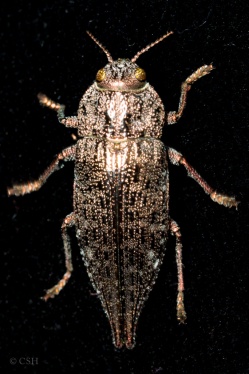 I found at least three species of jewel beetles (Coleoptera: Buprestidae), the one pictured here being the largest one. Buprestids are very often metallic colored and bullet-shaped. They are wood boring beetles, and will lay their eggs in trees where the larvae will feed and develop before emerging as adults. Some species can be huge pests, including the emerald ash borer and the bronze birch borer (a current pest in Corvallis and my own front yard). I am not very familiar with the identification of Burprestids, but this blog by a Missouri entomologist has more info about about a species that appears to be similar.
I found at least three species of jewel beetles (Coleoptera: Buprestidae), the one pictured here being the largest one. Buprestids are very often metallic colored and bullet-shaped. They are wood boring beetles, and will lay their eggs in trees where the larvae will feed and develop before emerging as adults. Some species can be huge pests, including the emerald ash borer and the bronze birch borer (a current pest in Corvallis and my own front yard). I am not very familiar with the identification of Burprestids, but this blog by a Missouri entomologist has more info about about a species that appears to be similar.
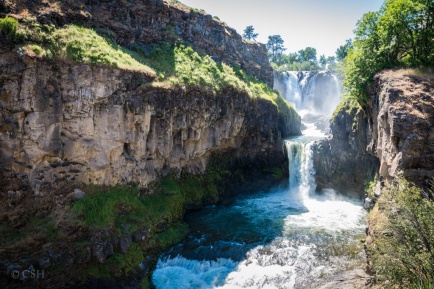 My next destination was White River Falls State Park, where last year we found many Brochymena in the black locust trees. The park is a large picnic area that overlooks a huge two-step waterfall that’s hidden away under the relatively flat landscape of Wasco County. Although last year we had great luck collecting at this site, this year I was not as lucky, finding zero stink bugs in the trees. In fact, I was surprised that I didn’t find many insects at all, other than grasshoppers of which there were hundreds. Collecting with a beat sheet is frustrating in windy areas, and my sheet kept getting pushed up while whatever was falling out of the trees was blown far clear of where I wanted it to land. If there were insects in those trees, they blew away before they got anywhere near my sheet. Being late afternoon by this point, I gave up for the day and took a break to hike down to the bottom of the falls.
My next destination was White River Falls State Park, where last year we found many Brochymena in the black locust trees. The park is a large picnic area that overlooks a huge two-step waterfall that’s hidden away under the relatively flat landscape of Wasco County. Although last year we had great luck collecting at this site, this year I was not as lucky, finding zero stink bugs in the trees. In fact, I was surprised that I didn’t find many insects at all, other than grasshoppers of which there were hundreds. Collecting with a beat sheet is frustrating in windy areas, and my sheet kept getting pushed up while whatever was falling out of the trees was blown far clear of where I wanted it to land. If there were insects in those trees, they blew away before they got anywhere near my sheet. Being late afternoon by this point, I gave up for the day and took a break to hike down to the bottom of the falls.
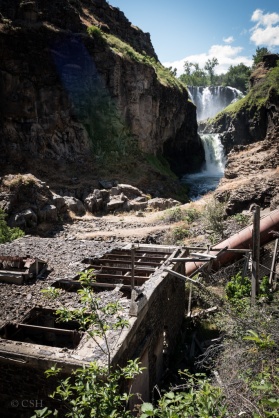 Down a dusty trail and a series of very steep wooden steps, you arrive at the ruins of the old power station that was used to supply electricity to Wasco County at the turn of the 20th Century. The station is about 25 feet tall, and it’s walls are thick, made of cold cement and cobblestone. Rusty bits of toothed metal litter the area and there’s a few old concrete foundations still remaining. Although there is a large sign forbidding you to go inside the station, there is also an old set of pipes that’s conveniently set up like a ladder leading into the old ruins making access fairly simple.
Down a dusty trail and a series of very steep wooden steps, you arrive at the ruins of the old power station that was used to supply electricity to Wasco County at the turn of the 20th Century. The station is about 25 feet tall, and it’s walls are thick, made of cold cement and cobblestone. Rusty bits of toothed metal litter the area and there’s a few old concrete foundations still remaining. Although there is a large sign forbidding you to go inside the station, there is also an old set of pipes that’s conveniently set up like a ladder leading into the old ruins making access fairly simple.
The decaying roof of the substation is covered in gravel and remnants of old corrugated metal. However, the building still feels very solid. It was built to house a large transformer and generator that supplied electricity for the machinery and mills in the Dalles. This site provided power until the stations at The Dalles were completed decades later. You can read a heated and detailed history of the struggles to get affordable power to the area at the Wasco County PUD site. The remains of the generator and accompanying machinery are still within the powerhouse walls, although now red and rusty and etched with graffiti. With so much sunlight coming in to the building through the holes in the roof and walls and windows, all of the creepiness that one would expect is gone, and instead a feeling of history about the site is strongly present.
 That’s not to say that there’s not a feeling of danger. Everything about this site feels intimidating and a little risky. On the far side of the ruins, there’s reminders of the danger of building at the bottom of a canyon. A huge boulder rests in a pile of rusted metal bits and other chucks of jagged rock, near the hole it likely made through the 8 inch thick brick wall. Outside of the building are the sounds of the constantly pounding waterfall, where there have been five drowning deaths in the last 4 years. The basalt rock walls that surround the powerhouse go straight up 150 feet looming over and casting cold shadows. The two foot diameter iron pipes that go into the powerhouse are covered in spiked rivets.
That’s not to say that there’s not a feeling of danger. Everything about this site feels intimidating and a little risky. On the far side of the ruins, there’s reminders of the danger of building at the bottom of a canyon. A huge boulder rests in a pile of rusted metal bits and other chucks of jagged rock, near the hole it likely made through the 8 inch thick brick wall. Outside of the building are the sounds of the constantly pounding waterfall, where there have been five drowning deaths in the last 4 years. The basalt rock walls that surround the powerhouse go straight up 150 feet looming over and casting cold shadows. The two foot diameter iron pipes that go into the powerhouse are covered in spiked rivets.
Despite the dangers and recent tragic events, White River Falls is still a beautiful park that’s hidden among the rangelands North Central Oregon. It’s worth a stop if you find yourself in the area, especially to see the falls that feel so out of place in this part of the state.
And, if you long for creepiness at your historical sites, there’s a a small chain link and barbed wire cage just a few feet along the trail that seemingly contains nothing but weeds and a pipe and a rusty padlock on the door.
